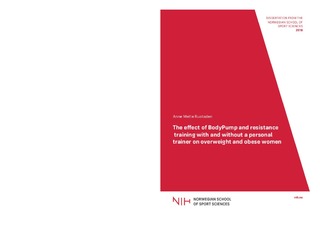| dc.contributor.author | Rustaden, Anne Mette | |
| dc.date.accessioned | 2018-12-05T11:18:44Z | |
| dc.date.available | 2018-12-05T11:18:44Z | |
| dc.date.issued | 2018 | |
| dc.identifier.isbn | 978-82-502-0563-5 | |
| dc.identifier.uri | http://hdl.handle.net/11250/2576132 | |
| dc.description | Avhandling (doktorgrad) - Norges idrettshøgskole, 2018 | nb_NO |
| dc.description.abstract | Background: Individuals categorized as overweight (BMI ≥25.0 kg/m2) or obese (BMI ≥30.0 kg/m2) are currently recommended to perform resistance training 2-3 times a week (60-80% of the 1RM). Although resistance training can be conducted in many different ways and at different venues, many choose to exercise at a health- and fitness club, where you typically can choose between strengthening group sessions, resistance training with a personal trainer and non-supervised resistance training. BodyPump is worldwide a popular group session, prechoreographed and distributed by LesMills International. The session consists of approximately 10 music tracks, exercises for the whole body and 800-1000 repetitions with low to moderate loads (a 1.25 kg barbell, and weights of 0.5 kg, 1.0 kg and 5.0 kg).
Methods and aims: The main purpose of this thesis was to conduct an assessor blinded randomized controlled trial, to investigate different effects of BodyPump and traditional heavy load resistance training (linear periodization, 8-10, 13-15 and 3-6 repetitions) with and without a personal trainer on overweight and obese women after 12 weeks of exercise (3 times/week). A total of 143 women were included and randomly assigned to BodyPump (n=37), resistance training with a personal trainer (n=35), non-supervised resistance training (n=35) or nonexercising controls (n=36). In paper I, the effect of resistance training on muscle strength and body composition were assessed, and in paper II the effect on self-reported musculoskeletal pain. In paper III, within- and between group differences in resting metabolic rate in a subgroup of the participants were assessed, while in paper IV energy expenditure during a single session of BodyPump (n=10) was assessed and compared with a single session of heavy load resistance training (n=8).
Results and conclusion: Losses to follow up were 32%, 17%, 40% and 35% in the BodyPump group, personal trainer group, non-supervised group and control group, respectively. In paper I, the BodyPump group showed no effect on muscle strength or body composition. The personal trainer group increased significantly more in 1RM squat than all the other groups (p≤0.001), and significantly more than the BodyPump group and controls in bench press (p≤0.001). There was no between group changes in body composition. In paper II, the results showed no differences in self-reported musculoskeletal pain at baseline or post-test. In paper III, the resting metabolic rate increased similar in the two groups (p=0.660); 8.5% (±10.8) in the BodyPump group and 10.5% (± 10.4) in the heavy load group. In paper IV, energy expenditure was similar in the two groups (p=0.69); 302 kcal ±67 during BodyPump and 289 kcal ±69 during heavy load resistance training (paper IV). | nb_NO |
| dc.description.abstract | Paper I: Rustaden AM, Haakstad LAH, Paulsen G, Bø K. Effects of BodyPump and resistance training with and without a personal trainer on muscle strength and body composition in overweight and obese women – a randomised controlled trial. Obes Res Clin Pract, 2017; 11(6): 728-739, doi: 10.1016/j.orcp.2017.03.003. | nb_NO |
| dc.description.abstract | Paper II: Rustaden AM, Hagen Haakstad LA, Paulsen G, Bø K. Is there any effect of BodyPump and heavy load resistance training on prevalence of musculoskeletal pain in overweight and obese women? A randomized controlled trial. Currently, under revision in Physiotherapy. | nb_NO |
| dc.description.abstract | Paper III: Rustaden AM, Gjestvang C, Bø K, Hagen Haakstad LA, Paulsen G. BodyPump versus traditional heavy load resistance training on changes in resting metabolic rate in overweight untrained women. J Sports Med Phys Fitnes, 2017; Jul 25. doi:10.23736/S0022-4707.17.07613-7J. | nb_NO |
| dc.description.abstract | Paper IV: Rustaden AM, Gjestvang C, Bø K, Hagen Haakstad LA, Paulsen G. Total workload and energy expenditure during high-repetition low-load resistance training versus traditional heavy load resistance training in overweight women. Currently, under revision in Research Quarterly for Exercise and Sport. | nb_NO |
| dc.language.iso | eng | nb_NO |
| dc.subject | nih | nb_NO |
| dc.subject | doktoravhandlinger | nb_NO |
| dc.subject | trening | |
| dc.subject | styrketrening | |
| dc.subject | kvinner | |
| dc.subject | overvektige | |
| dc.subject | fedme | |
| dc.subject | personlig tjener | |
| dc.subject | treningseffekt | |
| dc.subject | bmi | |
| dc.subject | muskelstyrke | |
| dc.title | The effect of BodyPump and resistance training with and without a personal trainer on overweight and obese women | nb_NO |
| dc.type | Doctoral thesis | nb_NO |
| dc.description.localcode | Seksjon for idrettsmedisinske fag / Department of Sport Medicine | nb_NO |
